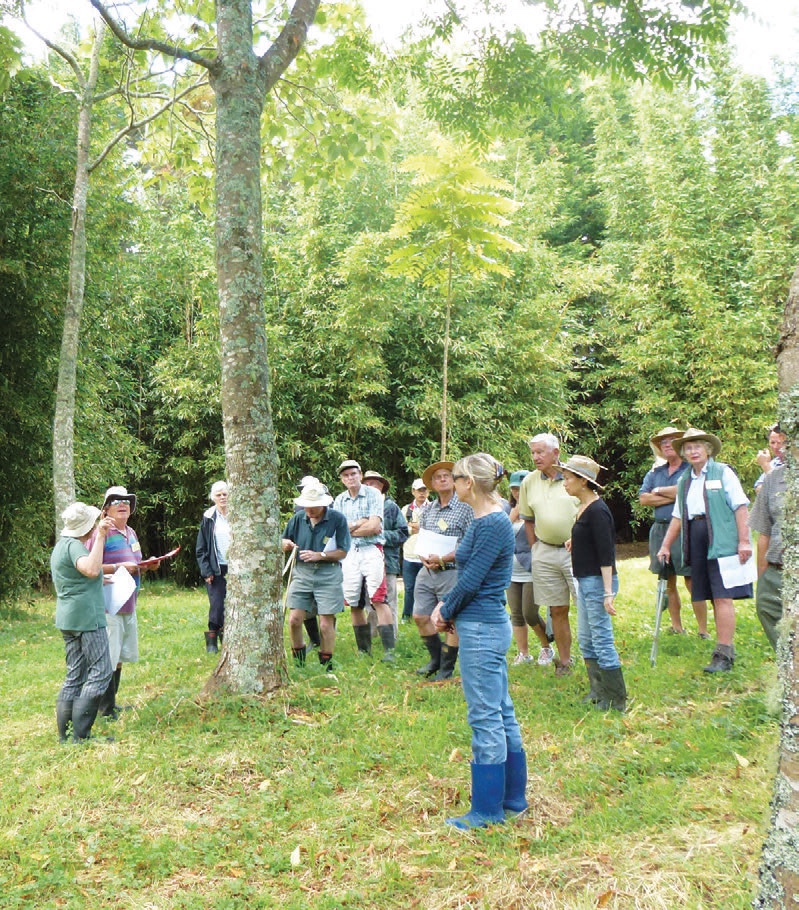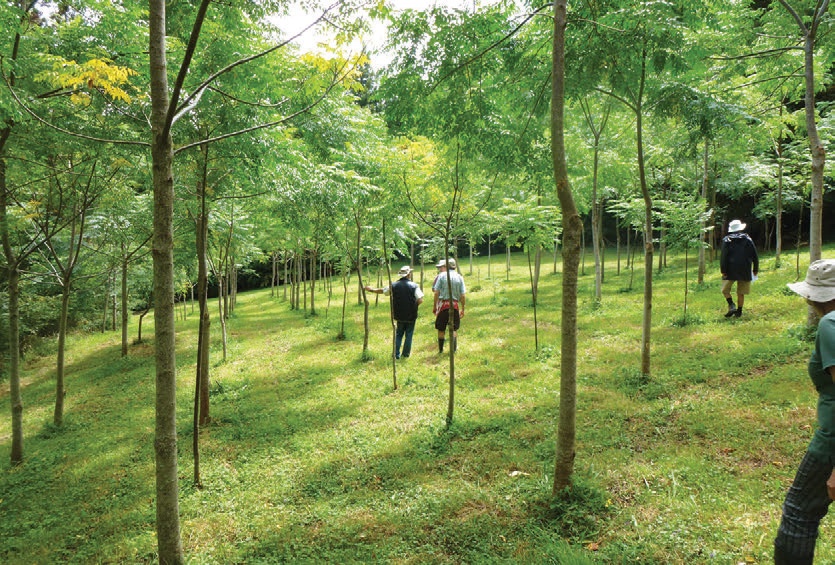Growing high value tree species in the Lower North
Wade Cornell, New Zealand Tree Grower May 2012.
Wade Cornell purchased his Waiatarua property in the Waitakere foothills in 1987. The soils are mostly heavy clays but not untypical of many areas in the north. Since then he has planted trials of well over 100 species including a range of provenances for some of the most promising. His comments below relate to some of the best performers however there are many which have shown some promise but may be better suited to other sites. A local branch field-day appreciated the opportunity to look at these.
New Zealand has a lot of great tree growing country with many trees growing much faster here than in their native habitat. Unfortunately radiata pine, New Zealand’s ubiquitous forestry species, has coloured perceptions of what to expect of a commercially grown tree. So far only radiata pine has proved resilient enough to plant from Cape Reinga to Bluff.
We must accept that most other species need to be grown in the right environment. For example cypresses are extremely susceptible to canker in warm wet areas so should only be grown in cooler drier areas, not the north. Conversely, redwoods grow best in warm wet areas and do not grow well in the cold dry areas that are best for healthy cypress. Subtropical species which are suited to the north are not suited to areas with heavy or unseasonal frost, which is most of New Zealand.
Adaptation to Northland conditions
In 1987 we began our species trials in the Lower North. At that time government-sponsored research organisations seemed to be somewhat disinterested in species for the warmer, wetter areas of the country. It was a smaller proportion of New Zealand and their focus was still on improving pine and being able to justify research as being applicable to most areas, which is fair enough.
Our primary investigations looked at general adaptation to Northland conditions and silviculture. At the same time market studies looked overseas and examined where high demand and firm prices exist, side-stepping the more common New Zealand chicken and egg dilemma.
Over 100 species went into our trials with only a few species emerging as having the winning combination of both excellent growth and high value markets. Most of these species must be grown as clones that are selected on the basis of their adaptation to our conditions. Clones must also be screened and selected for wood properties to ensure that the wood will be acceptable in target markets.
Redwood grows well
Redwood Sequoia sempervirens grows extremely vigorously in many areas of the north. Excessive wind is probably our most limiting factor. Currently a market exists for average quality logs returning $150 a cubic metre for export to Korea and Taiwan. This is a very limited market. The timber is used for coffins which may then be covered with other materials. Existing recent plantings will unfortunately swamp this market with no prospect for much expansion. The USA and California market, because of exchange rates which are not likely to recover significantly, along with shipping costs, could return less to the grower than the Asian coffin market.
Redwood’s highest potential value and use is for situations where natural durability and stability are required. Currently western red cedar dominates that market, but the resource is shrinking in North America and their second growth material is proving inferior. Appropriately selected redwood clones can produce a superior timber and enter this large, very lucrative market.
New Zealand imports approximately $20 million worth of western red cedar each year. The world wide market is worth over $1 billion annually. This market will not be available to those growing redwood seedlings or clones which have not been screened to match the wood properties required.
Variable as timber
Redwood is enormously variable in every respect, especially its wood properties which can be totally durable or non-durable with densities ranging from 240 kg a cubic metre to over 400 kg a cubic metre. Attempts to sell untested variable timber will kill those high value markets. The wholesale price for 150 mm by 50 mm clear western red cedar sells for around $2,000 a cubic metre. Other grades sell for less.
Good northland sites using well selected redwood clones can expect a 60 cm diameter at breast height log in around 20 years, but this is a work in progress. Research in conjunction with Canterbury University determining wood properties for western red cedar replacement and clonal selection are not yet completed. None of the currently available clones should be considered for western red cedar replacement at this time. Redwood seedlings should never be planted except for trials. Hopefully we will have the required information and appropriate clones available by 2013.
Australian red cedar
Australian red cedar Toona ciliata is Australia’s icon timber much the same as kauri is in New Zealand. It is a rainforest tree that grows as an individual within a natural matrix of many other species. Australia cannot have plantations of this desirable species due to the build-up of an insect pest, a tip borer. We do not have the tip borer yet which enables us to plant this fast growing species.

Red cedar is a Meliaceae and related to Honduran and African mahoganies. It has stable high quality wood with a typical mahogany flame grain pattern when back-cut. Seedling production in Northland is variable with a few specimens growing quickly with good form but most having extremely poor form. They are also sensitive to wind and require good shelter. Clonal selection will be mandatory for growth and form as well as ensuring that the preferred deep red-colour wood is grown.
Sydney wholesale price for clears starts at $4,000 a cubic metre and increases for good wide boards, or for very high quality with a deep colour. A good quality tree on a good site in Northland can achieve a diameter at breast height of 60 cm in 20 years. Clones for trials could be available in two years if there is grower demand.
Tallowwood
Tallowwood Eucalyptus microcorys is generally considered a stringybark, but is significantly different from the others. It is shade tolerant and not as crown-shy as most other eucalypts. The wood is considered an extremely high quality flooring material. It is structurally strong and the heart is classified as having class one durability. It generally commands a premium over most other eucalypts. Logs can be milled to the pith even at young ages, with good stability and recovery.
E. microcorys has one fault in that it has a tendency towards poor form when grown in open paddocks. However its ability to grow in some shade allows it to be used to under-plant scrub or other trees. The result is a straight trunk which bursts through the canopy and crowns over the top. Lower small branches drop off eliminating the need for pruning. Is there anyone out there considering a cost effective conversion to get out of pine? Rotations can be from 15 to 25 years as conversions are good even in moderate diameter logs. It can be grown now using high quality seed.
Indian bead tree
There is an interesting trial with Melia azedarach, the Indian bead tree, commonly used for street planting in some parts of Auckland and in northern Australia. The tree has been planted on a commercial scale in Argentina and grows rapidly. However it is important to get the provenance right. As a member of the Meliacea it can also exhibit mahogany-type wood properties.

Economic realities dictate that anyone considering planting trees needs to ensure that they will enjoy a good return for their efforts. Commodity and industrial timbers are likely to continue to find it difficult to justify low returns while land values remain high. High value species have the potential to lift returns by diversification and working with markets which may not be as entrapped in commodity price cycles. For those who are fortunate enough to be in the right environments to grow high value species I frankly think you would be nuts not to.

 Farm Forestry New Zealand
Farm Forestry New Zealand